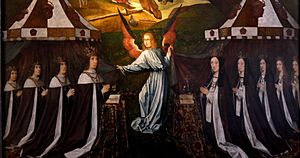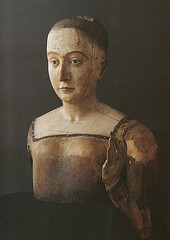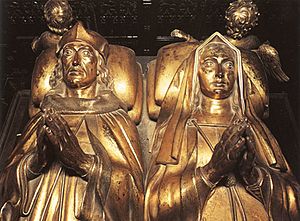Elizabeth of York facts for kids
Quick facts for kids Elizabeth of York |
|
|---|---|
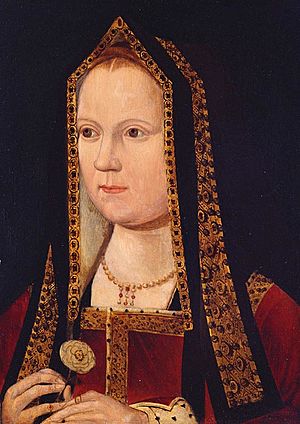
Contemporary portrait, late 1400s
|
|
| Queen consort of England | |
| Tenure | 18 January 1486 – 11 February 1503 |
| Coronation | 25 November 1487 |
| Born | 11 February 1466 Westminster Palace, Middlesex, England |
| Died | 11 February 1503 (aged 37) Tower of London, London, England |
| Burial | 24 February 1503 Westminster Abbey |
| Spouse | Henry VII of England |
| Issue more... |
|
| House | York |
| Father | Edward IV of England |
| Mother | Elizabeth Woodville |
| Religion | Roman Catholicism |
| Signature | |
Elizabeth of York (born 11 February 1466 – died 11 February 1503) was the Queen of England. She became queen when she married King Henry VII on 18 January 1486. She remained queen until her death in 1503.
Elizabeth married Henry after he won the Battle of Bosworth Field. This battle ended the Wars of the Roses, a long fight between two powerful families. Elizabeth and Henry had seven children together.
Elizabeth's younger brothers, known as the "Princes in the Tower", disappeared mysteriously. This happened soon after her father, King Edward IV, died. A law from 1484, called Titulus Regius, said her parents' marriage was not valid. But Elizabeth and her sisters were still welcomed back to court by her uncle, King Richard III.
Henry Tudor knew he needed support from Elizabeth's family (the Yorkists) to become king. He promised to marry Elizabeth before he even arrived in England. This promise helped him gain support and weakened Richard III's position.
Elizabeth did not seem to play a big role in politics. Her marriage to Henry appears to have been happy. However, her oldest son, Arthur, Prince of Wales, died at age 15 in 1502. Three other children also died young. Her second son, Henry, became King Henry VIII of England. Her daughters, Margaret and Mary, became queens of Scotland and France.
Contents
Elizabeth's Early Life and Family
Born into Royalty
Elizabeth of York was born at the Palace of Westminster. She was the oldest child of King Edward IV and his wife, Elizabeth Woodville. Her christening (a special church ceremony) took place at Westminster Abbey. Her grandmothers, Jacquetta of Luxembourg and Cecily Neville, were her sponsors.
When Elizabeth was three, she was briefly promised in marriage to George Neville. But his father later rebelled against King Edward IV, so the marriage plan was cancelled. In 1475, Louis XI of France agreed that Elizabeth would marry his son, Charles. However, Louis XI changed his mind in 1482. In 1477, at age eleven, Elizabeth was made a Lady of the Garter. This was a special honor.
Her Brother, King Edward V
On 9 April 1483, Elizabeth's father, King Edward IV, died suddenly. Her younger brother, Edward V, became the new king. Her uncle, Richard, Duke of Gloucester, was chosen to look after his nephews.
Richard wanted to keep his nephews away from their mother's family, the Woodvilles. He took Edward V to the Tower of London, saying it was for his protection. Edward's uncle, Anthony Woodville, and half-brother, Richard Grey, were arrested. Elizabeth Woodville, with her younger son Richard and her daughters, found safety in Westminster Abbey. Richard then asked for young Richard to join his brother Edward in the Tower. Elizabeth Woodville eventually agreed.
Two months later, on 22 June 1483, it was announced that Edward IV's marriage was not valid. This meant his children, including Elizabeth, were no longer considered rightful heirs to the throne. A law called Titulus Regius supported this idea. This made Richard, Duke of Gloucester, the rightful king. He became King Richard III on 6 July 1483. Edward and Richard, the "Princes in the Tower," disappeared soon after. People began to whisper that they had been murdered.
Her Uncle, King Richard III
After her brothers disappeared, Elizabeth's mother, Elizabeth Woodville, made a secret plan. She teamed up with Lady Margaret Beaufort, the mother of Henry Tudor. Henry Tudor wanted to become king. He was from the Lancastrian family, who had been fighting Elizabeth's family, the Yorkists.
Henry Tudor's claim to the throne was not very strong. But Elizabeth's mother and Lady Margaret Beaufort agreed that Henry should try to become king. If he succeeded, he would marry Elizabeth of York. This marriage would help make his claim stronger. In December 1483, Henry Tudor promised to marry Elizabeth.
In 1484, Elizabeth and her sisters left Westminster Abbey and returned to court. This happened after her mother seemed to make peace with Richard III. There were rumors that Richard III wanted to marry Elizabeth himself, as his wife, Anne Neville, was dying. But Richard denied these rumors. After Anne Neville died, Richard sent Elizabeth away from court. He then tried to arrange other marriages for himself and Elizabeth.
Henry Tudor landed in Wales with his army on 7 August 1485. On 22 August, Henry Tudor and Richard III fought at the Battle of Bosworth Field. Richard III had a larger army, but he was betrayed and died in battle. Henry Tudor became King Henry VII.
Queen of England
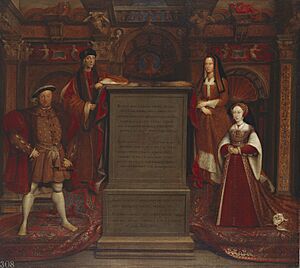
Marriage to Henry VII
Henry VII was slow to keep his promise to marry Elizabeth. He wanted to show that he became king by his own power, not just by marrying Elizabeth. But he knew marrying her was important to make his rule stable. It would also weaken the claims of other members of the House of York.
Henry VII cancelled the law called Titulus Regius. This made Elizabeth and her siblings rightful heirs again. Henry and Elizabeth needed special permission from the Pope to marry. This was because they were distant cousins. The Pope approved their marriage in March 1486.
Cardinal Bourchier led the wedding ceremony for Henry VII and Elizabeth of York. They married on 18 January 1486 in Westminster Abbey. Their first son, Arthur, was born eight months later, on 20 September 1486. Elizabeth of York was crowned queen on 25 November 1487. She had several more children, but only four survived childhood: Arthur, Margaret, Henry, and Mary.
Life as Queen
Even though their marriage was arranged for political reasons, Henry and Elizabeth seemed to grow to love each other. One writer said their marriage was full of "faithful love." Henry found great strength from Elizabeth.
Henry understood that showing off his wealth was important for his new family, the Tudors. Elizabeth had grown up in a royal court. She helped shape the court's appearance and proper behavior. This was important because Henry had not lived in England since he was 14.
To keep peace after the long civil war, the new Tudor family needed to unite the Yorkist and Lancastrian sides. Elizabeth's sisters, Cecily and Anne, and her cousin, Margaret Pole, married men loyal to Henry. Elizabeth cared about her female relatives and wanted them to be well.
Some historical records show that Henry was not always seen as a kind husband. But other records, like Elizabeth's own spending accounts, suggest this might not be true. Elizabeth was a very religious woman. She gave away a lot of money to charity and to religious groups.
Evidence from old documents shows that Henry was generous to his children, mother, and wife. He loved music, parties, and dancing on special occasions. Elizabeth also won the trust of Henry's friends and supporters.
Elsyng Palace was one of the places where Henry and Elizabeth's children grew up. Elizabeth spent a lot of time there. A friend of Henry's started improving the palace soon after Henry became king. It was made into a beautiful home for the royal family.
Elizabeth had a grand coronation. She was carried on a royal boat down the River Thames. It is now known that Elizabeth helped design the former Greenwich Palace. This palace was perfect for large parties. Christmas was a very lively time for the royal family. They had lots of imported wine, roasted meats, and entertainers. Henry often bought gifts for Elizabeth and their children. His account books show he spent a lot of gold on expensive clothes for his family.
Elizabeth of York did not have much political power as queen. This was partly because Henry's mother, Lady Margaret Beaufort, was very strong-minded. But Elizabeth was known for being gentle, kind, and generous. Henry even chose Elizabeth's pick for a bishop over his mother's choice once. This shows he listened to Elizabeth.
She loved books and supported the English printer William Caxton. Elizabeth also enjoyed music, dancing, and gambling, which she shared with her husband. She also kept greyhounds.
As queen, Elizabeth made sure her younger children, including the future Henry VIII, were well educated. She also went with her husband on a trip to Calais in 1500 to meet Philip I of Castile. She wrote letters to Queen Isabella I of Castile before their children married.
On 14 November 1501, Elizabeth's 15-year-old son Arthur married Catherine of Aragon. Catherine was the daughter of King Ferdinand II of Aragon and Queen Isabella I of Castile. Arthur and Catherine went to Ludlow Castle. But Arthur died in April 1502.
News of Arthur's death made Henry VII very sad. Elizabeth comforted him. She reminded him that he had survived as the only child of his mother to become king. She also said God had left them with another son and two daughters. She told him they were young enough to have more children. But when Elizabeth was alone, she also cried with grief. Henry then came to comfort her.
Death and Legacy
In 1502, Elizabeth of York became pregnant again. She stayed at the Tower of London during this time. On 2 February 1503, she gave birth to a daughter, Katherine. Sadly, Katherine died just eight days later. Elizabeth of York died on 11 February, her 37th birthday. She died from an infection after childbirth.
Her family was very sad about her death. It is said that Henry VII was heartbroken. He went to a private place and did not want anyone to see him. Soon after, Henry himself became very ill. He would only let his mother, Margaret Beaufort, near him. It was very unusual for Henry to show such strong emotions or weakness.
In 2012, a special old book called the Vaux Passional was found. It used to belong to Henry VII. The book shows how sad everyone was after Elizabeth's death. Henry VII is shown wearing black mourning clothes. His daughters, Mary and Margaret, are also shown in black. Young Prince Henry, who was 11, is shown crying into his mother's empty bed.
Henry VII thought about marrying again to make new alliances with other countries. But he died a widower in 1509. When he described what he wanted in a new wife, he described Elizabeth. Every year on the anniversary of her death, he ordered special prayers, bells to be rung, and 100 candles to be lit for her. He also kept her musicians employed.
The Tower of London was no longer used as a royal home after Elizabeth's death. Royal babies after 1503 were born in other palaces.
Henry VII's reputation for being careful with money became even stronger after Elizabeth died.
He was buried with Elizabeth of York in his chapel at Westminster Abbey. Their tombs have beautiful statues of them.
Elizabeth's Children
- Arthur, Prince of Wales (born 20 September 1486 – died 2 April 1502)
- Margaret, Queen of Scotland (born 28 November 1489 – died 18 October 1541)
- Henry VIII, King of England (born 28 June 1491 – died 28 January 1547)
- Elizabeth (born 2 July 1492 – died 14 September 1495)
- Mary, Queen of France (born 18 March 1496 – died 25 June 1533)
- Edmund (born 21 February 1499 – died 19 June 1500)
- Katherine (born 2 February 1503 – died 10 February 1503)
Appearance and Symbols
Some people believe that the "queen ... in the parlour" from the nursery rhyme "Sing a Song of Sixpence" is Elizabeth of York. The king counting his money would be Henry VII.
The symbol of the Tudor dynasty is the Tudor rose. This rose became a royal symbol for England after Elizabeth married Henry VII in 1486. Her White Rose of York joined with her husband's Red Rose of Lancaster. Today, the Tudor rose is still the floral emblem of England.
Elizabeth of York was known for her beauty. She was tall for her time, about 5 feet 6 inches (168 cm), with fair skin and regular features. She inherited her height and looks from her father, Edward IV, and her mother, Elizabeth Woodville. All later Tudor monarchs inherited her reddish-gold hair. This hair color became a famous trait of the Tudor family.
Elizabeth in Movies and TV
- In 1995, Kate Steavenson-Payne played her in the movie Richard III.
- In 2013, Freya Mavor played her in the BBC series The White Queen.
- In 2017, Jodie Comer played Elizabeth in the BBC series The White Princess.
- In 2019, Alexandra Moen played her in the Starz series The Spanish Princess.
See also
 In Spanish: Isabel de York para niños
In Spanish: Isabel de York para niños



